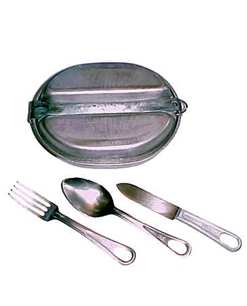M1926 KNIFE, FORK, SPOON AND M1932 OR M1942 MEATCAN

No soldier wants to be without these items when a hot meal is available! The meatcan lid was a two-compartment dinner plate and the bottom served as a frying pan when the handle was folded out. The D-ring on the back of the meatcan lid could be slipped over the extended handle of the bottom section so that the plate rested securely on the handle and the soldier could hold both with one hand in the mess line. The other hand was needed to hold the canteen cup. For health reasons, the cleanliness of mess gear was an important issue. After a meal from a field kitchen the mess kit would be scraped clean, swished in boiling soapy water for sterilization, and rinsed in two more cans of hot water. The cooks set up the three wash cans for the troops.
The utensils are stamped from tin plated steel or rust resistant steel and are readily distinguishable from the WWI period utensils because the handles have holes through them permitting them to be slipped over the handle of the meatcan for easier sterilization in boiling water. It is more difficult differentiating WWII utensils from the post-war ones since that pattern is the same. It is permissible to use post war utensils. All are stamped "U.S." on the front. The contractor name is usually present but dates appear only on the knives and then not consistently. The knife handle is either a cast silver metal or black plastic; the later is undoubtedly WWII period.
The meatcan will always be contractor marked and dated on the handle. The M1932 type has the same style heavy, 1/8" thick, narrow handle and cast-mounting hinge that the WWI meatcan had. Unlike the WWI meatcans the M1932 and M1942 types have a body of corrosion resistant steel. The M1942 meatcan was simplified by stamping the handle and mounting hinge out of thin corrosion resistant steel. The thin steel handle was made wider, about 1’, to compensate for the loss of strength caused by using the thinner metal.